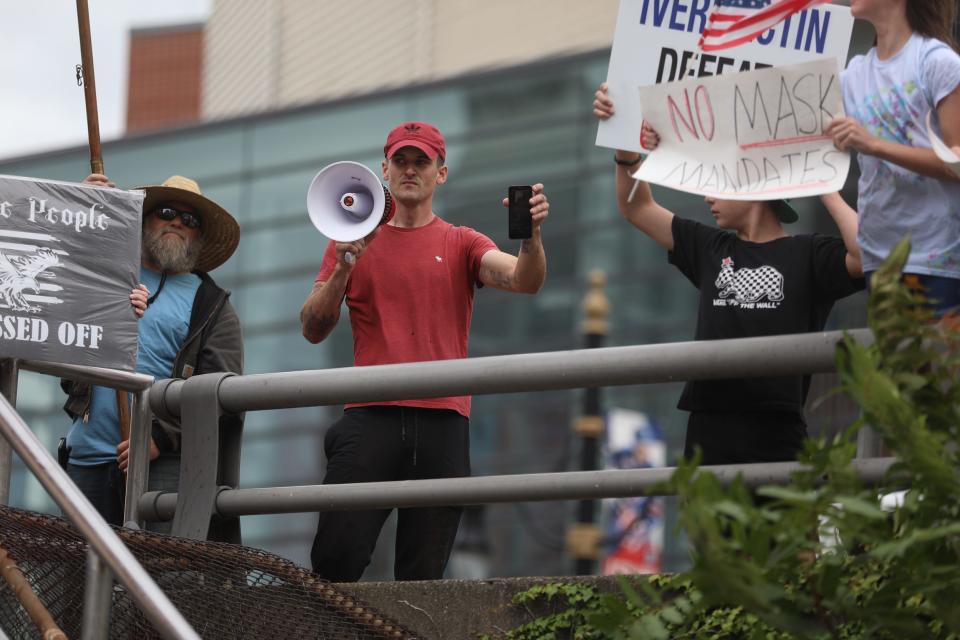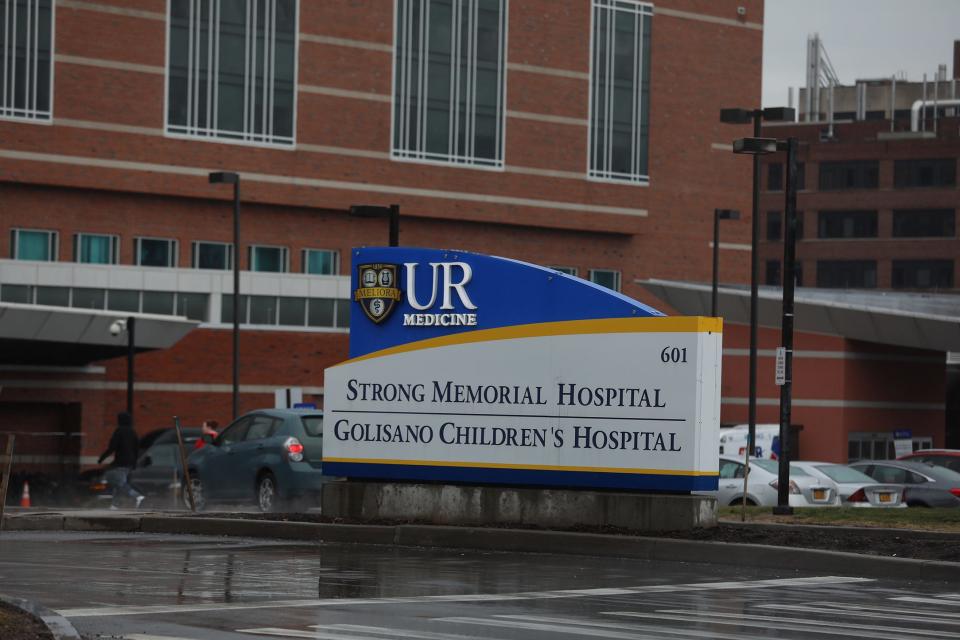Will New York renew mask mandate and COVID-19 restrictions? What to know as cases surge
- Oops!Something went wrong.Please try again later.
New York’s growing COVID-19 surge threatens to trigger a crushing wave of infections in many communities outside the New York City area, casting a cloud of uncertainty over the coming holiday season.
In some regions — including the Finger Lakes, Southern Tier and Mohawk Valley — coronavirus hospitalizations this month have outpaced a year ago, when holiday gatherings sparked outbreaks during upstate New York’s darkest pandemic days, which peaked in mid-January.
Addressing the renewed danger, authorities scrambled this week to expand access to COVID-19 booster shots to all adults and urged millions of still unvaccinated New Yorkers to get shots.
The last-ditch moves aimed to close gaps in herd immunity against COVID-19 with the statewide partial vaccination rate at about 76%.
Health officials also voiced concerns the highly contagious COVID-19 delta variant, which emerged in July, would rapidly spread as more people gathered indoors during cold weather.
The virus posed a heightened risk in many upstate counties with partial vaccination rates between 50% and 70%, compared to 80% and above in Westchester County and parts of New York City.
Yet state and local officials stopped short of deploying new mask mandates and pandemic restrictions, in hopes New Yorkers would voluntarily take steps to reduce the virus’ spread.
“Nobody wants to go back to what we saw last year where we had mandates imposed and businesses shutting down,” Monroe County Executive Adam Bello said Monday, adding officials would monitor outbreaks in coming days.
Despite the mounting warning signs, Gov. Kathy Hochul stuck to her pledge to allow local officials to dictate regional COVID-19 responses. But she warned Tuesday that the state would take over if conditions worsen.
“If there’s no progress, we’re going to have to have stricter measures,” she said during a briefing in Buffalo.
The moment evoked memories of the pandemic’s early stages in spring 2020, when experts asserted delays in closing schools and imposing mask mandates potentially cost thousands of lives as COVID-19 ravaged New York City.
Meanwhile, hospitals in the cities of Buffalo and Rochester currently face a glut of mostly unvaccinated COVID-19 patients, health leaders said, noting some patients came from neighboring rural counties, such as Orleans, Genesee and Wyoming, with low vaccination rates.
“Every staffed bed we have in the hospital is occupied,” Erie County Medical Center’s Chief Medical Officer Dr. Brian Murray said, adding many days up to 30 patients were in the emergency room waiting for inpatient beds.
“It is eerily similar to what we experienced last November,” he added.
What Gov. Hochul is doing about COVID surge

While much of upstate New York faced COVID-19 test positivity rates between 5% and 9%, New York City, Long Island, and the Lower Hudson Valley’s rates hovered between 1% and 3%.
Citing the divide, Hochul suggested the state is considering localized restrictions on social and economic activity to combat outbreaks.
More: NY expanding COVID booster eligibility to those who 'feel at risk.' What to know
More: COVID cases surge in Monroe County schools. Here are the schools hit the hardest
“What I am not looking for is a broad-brush statewide approach to treat every region of the state identically when the circumstances are so vastly different,” she said Tuesday in Buffalo.
Hochul encouraged local officials to consider following the pandemic example set by New York City, such as requiring proof of vaccination for many indoor activities, including dining.
“Those options are out there,” she said, “Every community needs to assess what is important to them, but I want to make sure the tools are out there so communities can make their own risk assessment.”
Hochul also asserted many people upstate were failing to voluntarily wear masks in public settings, as opposed to robust mask use downstate.
But the lack of details on how and when new COVID-19 restrictions and policies could be imposed locally raised many questions, spanning economic, educational and social issues, said Dr. Dial Hewlett, an Infectious Diseases Society of America expert.
“For public health, we have to have very clear guidance from the top down,” said Hewlett, who is also a Westchester County health official.
“It starts with our federal guidance and hopefully states will be in harmony with that,” he added.
For example, recent confusion surrounding the expansion of COVID-19 booster eligibility, Hewlett noted, stemmed from mixed messaging from the White House and federal regulators this fall.
Still, Hochul seemingly offered hints Tuesday into what metrics New York could consider for imposing COVID-19 restrictions, such as indoor mask mandates and capacity limits for indoor events.
Communities with 5% or above COVID-19 test positivity “should be concerned” about the risk, she said, addressing her policy that any adults who “feel at risk” are eligible for boosters.
Why COVID cases are rising in NY

Health officials and hospital leaders from Erie and Monroe counties held a joint media briefing Monday to detail the delta variant’s rapid resurgence in recent weeks.
“The reality is again we’re entering another uncertain period of the pandemic,” Monroe County Health Commissioner Dr. Michael Mendoza said, noting pockets of unvaccinated New Yorkers were fueling outbreaks and straining hospitals.
More: New safety grades show how NY hospitals performed before, during COVID-19 pandemic
The origins of the current COVID-19 surge, in part, traced to many New Yorkers in upstate communities relaxing pandemic precautions this fall, as some people ditched mask wearing and resumed indoor gatherings, health officials said.
“Even with the vast majority of eligible adults vaccinated in our communities, we are seeing more daily cases today than one year ago,” Mendoza said, noting the related rise in hospitalizations should trigger alarms.
“We let our guard down too soon,” he said, adding the state would be facing “a much greater hardship” if 14.6 million New Yorkers had not been at least partially vaccinated so far.
Further, about 30% of daily cases in Monroe County are among the vaccinated, Mendoza said, addressing how breakthrough infections among the vaccinated will remain a threat while other people continue to refuse shots.
“Our efforts did matter, and they still matter,” he said.
Dr. Michael Apostolakos, chief medical officer of UR Medicine, noted the Rochester-based health system may soon need to temporarily reduce non-COVID related care, citing patients currently waiting in ERs for inpatient beds.
“If this surge continues, and worsens, we are at risk to limit some of the elective things we do,” he said, adding 80% of the COVID-19 patients in the intensive care unit, or ICU, are unvaccinated.
Further, the severely ill unvaccinated COVID-19 patients are generally in their 50s, as opposed to the limited vaccinated ICU patients in their 70s and above, he added.
In Erie County, contact tracing shows the current surge is partially fueled by social gatherings at homes and bars, Erie County Health Commissioner Dr. Gale R. Burstein said, calling on people to limit the size of gatherings and keep them exclusively among vaccinated.
Many health leaders also sympathized with New Yorkers' pandemic fatigue but urged them to recommit to social distancing, mask wearing and vaccination during what, hopefully, should be the final surge before a return to normalcy.
“I’m sick of it too, however, I would rather be sick of it than be dead or see my loved ones dead,” Burstein said.
Erie County Executive Mark Poloncarz described the moment as a call to action, warning of mask mandates and other restrictions if cases don’t soon stabilize.
“I really don’t want to issue those mandates, but if I have to implement additional mandates and restriction then I will,” he said.
As for the potential timing of imposing mask mandates and other restrictions, local officials offered limited details beyond that daily infections and hospitalizations will be watched closely.
Hewlett, the infectious-diseases expert, described it as a balancing act between public health needs and politically charged debate over the pandemic response.
“I don’t think it’s too late, but as soon as you start to talk about mandates a lot of people become upset,” he said, adding the aim is to convince people of the benefits of being vaccinated and risks of refusing shots.
“After you’ve given that a reasonable try, mandates are essentially required if you cannot really achieve a level of herd immunity through voluntary efforts,” he added.
Support local journalism
We cover the stories from the New York State Capitol and across New York that matter most to you and your family. Please consider supporting our efforts with a subscription to the New York publication nearest you.
David Robinson is the state health care reporter for the USA TODAY Network New York. He can be reached at drobinson@gannett.com and followed on Twitter: @DrobinsonLoHud
This article originally appeared on New York State Team: Will New York renew mask mandate and COVID restrictions? What to know

